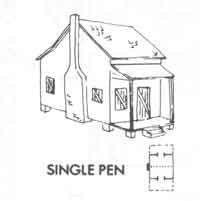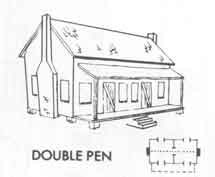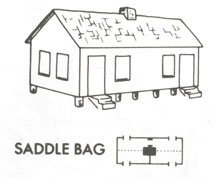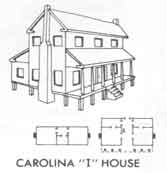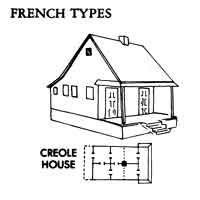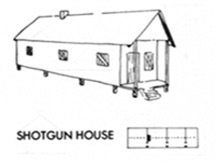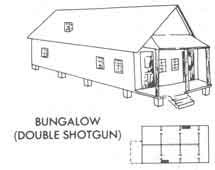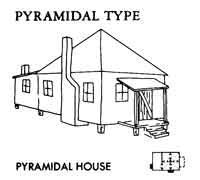House Types Found in Region 2, Red River Valley and the Neutral Strip 1
by Shawna Atkins
The Single Pen is a modest, one-room house built on piers one to three feet off of the ground. A common house type in the American Pioneer Period, the single pen was sometimes found in rural Protestant Louisiana. Although the house type could be built of any material, lumber or log was the most frequent choice. In addition to the one room of indoor living space, front porches and back porches were usually added to create areas for outside living or storage. The interior room measured approximately 16x16 feet, and the porches measured about half of the house size. Most importantly, the single pen often served as the core to which other rooms were added, thus creating other house types like the double pen.
Brought to Louisiana by settlers during the American Pioneer Period, the Double Pen was most commonly found on plantations along the Red and Mississippi Rivers. In rural North Louisiana, the Double Pen is often the result of additions to a Single Pen due to a growing family or other need for space. The two rooms of a Double Pen were built side by side and were connected at the gabled ends. Typically, there was a front porch running the length of the house and each room had a front door opening onto the porch. Each room also had an external chimney on opposite ends of the house. The placement of the chimney is very important in identifying similar house types, especially the Double Pen and Saddlebag.
The Saddlebag is essentially a Double Pen with a chimney in the middle of the house in the common wall between two rooms falling on either side. In the Saddlebag, one chimney with two openings is used to warm both rooms, which are connected by one or two doors. If the house is built of log, however, it is difficult to have a common wall due to the corner notches. In this case, there are two walls. This leaves a space of about four feet, which is just enough for a storage closet or possibly an entrance hall. The hall does not run between the rooms as in the Dog-Trot, however, since the chimney connects them.
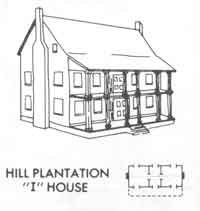
Hill Plantation I-House
All I-Houses are two-story structures, two rooms wide and one room deep, with end gabled roofs. The Hill Plantation type, however, includes outside end chimneys, a two-story front porch, and a two-story shed porch in back. The Hill Plantation type may also have a central hall, or additions to the side, dormers, columns. This house type is raised above the ground and is usually built of lumber. Although many of these houses began as small, one-story houses, they grew along with the owners’ economic status. Hill Plantation I-Houses are found in all rural plantation areas and sometimes in the more urban parish seats. [I-House examples documented by Dr. Stokes are Carolina style I-houses.]
Another variation of the I-House is the Carolina I-House. This type is similar to the Hill Plantation I-House except that the front porch and rear shed are one story instead of two. The Carolina I-House is found in the Upland South parts of North Louisiana, but occurs mostly in the Florida Parishes of East and West Feliciana. The presence of this house type suggests immigrant populations from the Carolinas.
Adopted by French and Creloes in Northern Louisiana, the smaller Creole House is actually a modified Caribbean French house type. Found in towns and in rural locations, the smaller Creole house consisted of two main rooms with a common chimney, three back rooms and a full porch, all under a continuous pitch roof. The common chimney inside the house is an important feature of this house type, and was traditionally made of mud and sticks. In the traditional style the walls were made of half-timber framing and filled with mud and moss, a mixture called bousillage. Outside walls were weather boarded, and the front wall under the porch was white washed. Later homes built in the Creole House tradition, but that do not use bousillage, often still have a white front wall to reflect traditional practices.
The Shotgun House is long and narrow, at least three rooms deep and only one room wide, with the front door on the narrow gabled end. There is almost always some sort of front porch and chimney, although the placement of the chimney varies greatly. This house type is common in older urban neighborhoods, since it is well suited for narrow city lots. It was once popular as plantation quarters and tenant houses. Other uses include fisherman cottages and loggers’ quarters, and this type of housing was common in sawmill communities throughout Louisiana. This house type probably has African origins, and was modified in the Caribbean and the brought to North America.
One of the most common house types in Louisiana, the bungalow is essentially a double shotgun. The standard size is two rooms wide and three rooms deep, but longer houses may be found. The placement of the chimney is variable and the style of the front porch ranges from simple shed to elaborate, integrated front and side porch. The popularity of this type of house can be attributed to the Craftsman Movement of the early twentieth century.
The pyramidal house has a connection to sawmills and is found throughout the state, but is most commonly found in the western part of the state. Although the sawmill connection is not completely understood, it is apparent that this house type occurs more frequently after the appearance of sawmills. The four room, square house is always built of lumber and always has the distinct pyramidal or hipped roof, consisting of four sides coming to a point. The chimney may be either internal or external, and there may or may not be small porches or sheds. Another regular feature is that the house sits on piers about one foot off the ground.
Bibliography
Martin, F. Lestar
2000 Folk and Styled Architecture in North Louisiana, Volume II: The River Parishes. The Center for Louisiana Studies, University of Louisiana at Lafayette.
Newton, Milton, B., Jr.
1971 Louisiana House Types: A Field Guide. Mâelanges No. 2. Museum of Geoscience Baton Rouge: Louisiana State University.
1972 Atlas of Louisiana: A Guide for Students. School of Geoscience Miscellaneous Publication 72-1. Baton Rouge: Louisiana State University.
Phillips, Yvonne
1963 The Shotgun House. Louisiana Studies 2.3:178-79.
Vlach, John Michael
1986 The Shotgun House: An African American Legacy. Common Places: Readings in American Vernacular Architecture. Dell Upton and John Michael Vlach, eds.. Athens: University of Georgia Press, 1986.
1Information for house type descriptions is taken primarily from Newton (1971). House drawings are from Newton (1972).
Stokes Collection home page | Dr. Stokes' description of the collection
View of map used by Dr. Stokes | House types with examples
